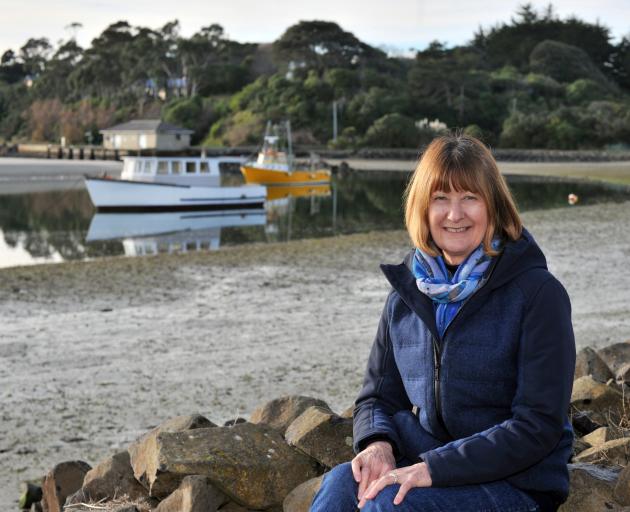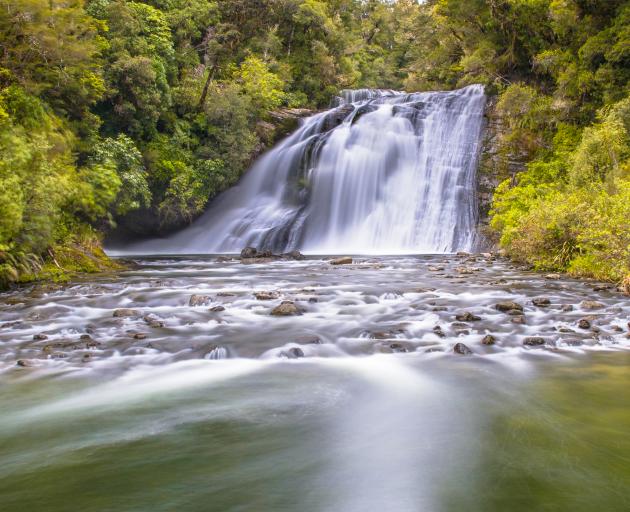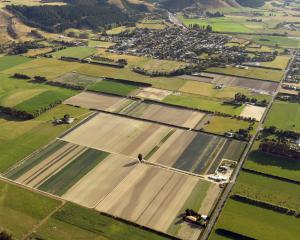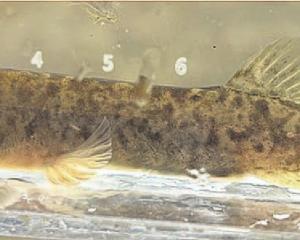
There are a couple of variations on the meaning of Waikouaiti, Dr Lyn Carter says.
Some say it refers to flash flooding. Others that it refers to the speed at which the tide rushes in and out through the river estuary.
"Either way it has that impact of a flash flood of water coming and going," Dr Carter says.
There have been repeated flood events, the most recent in 2017.
"The impact that those floods had on each generation is known.
"One of the things that is going to happen to us on our particular stretch of the coastline is increased flooding and that will occur through our river," Dr Carter says of the likely impacts of climate change.
"So we are looking at ways of, `OK, so how did [previous generations] cope with that? What were some of the mechanisms that were put in place?'."
Dr Carter, who lectures at the University of Otago, is a member of Kati Huirapa Runaka ki Puketeraki, and lives near the Waikouaiti River.
In her day job at Te Tumu - the School of Maori, Pacific and Indigenous Studies - she looks at the social impact of climate change and the relationship between landscape and identity, among other things.
A recent book of hers, Indigenous Pacific Approaches To Climate Change Aotearoa/New Zealand, details some of this scholarship.
As a member of her community she is thinking about and working on these things, too.

She cites the well-known aphorism "Maori walk backwards into the future".
"Past experiences help guide us when new challenges emerge for each new generation. We look to the lessons that our ancestors have left for us."
In te reo, that is matauraka (or matauranga) Maori, the Maori knowledge framework.
The specific solution required for a given situation might not be there packaged ready to go, but there'll be something, a direction.
Confidence that lessons from the past will serve again in the future is tied up with the belief, or world view, that the runaka has become embedded in the ecosystem, a part of it. There's an ongoing relationship between the people and the land and its resources that changes over time, adjusts as necessary, but endures.
"With all indigenous peoples there is that intrinsic connection with land.
"It is an old association, it's ancestral engagement that has been passed down the generations," Dr Carter says.
This is expressed best in te reo. So the word takata (tangata) means people and whenua means land or placenta; combined they mean people from the land.
"Nga Puhi tribal elder Maori Marsden described it as man [sic] being `an integral part therefore of the natural order and recipients of her [mother earth] bounty'," Dr Carter records in her book.
The practical value of that sort of intimate relationship with the environment is getting more attention internationally, as people cast around for solutions to the various environmental issues the world faces; climate change among them.
In the UN Intergovernmental Panel on Climate Change's Fourth Assessment Report (2007) it identified local knowledge as "an important, yet, to date overlooked component of its previous work and assessments".
In its October special report last year, the IPCC again emphasised the part indigenous knowledge can play in the response to global heating.
"Education, information, and community approaches, including those that are informed by indigenous knowledge and local knowledge, can accelerate the wide-scale behaviour changes consistent with adapting to and limiting global warming to 1.5degC," it wrote.
The IPCC's endorsement runs alongside a rapidly spreading understanding that the European, particularly post-Enlightenment, view of the earth as a resource to be exploited, something separate from us, has significantly contributed towards the development of the various ecological crises we face.
In his influential book the Patterning Instinct, Jeremy Lent says this mechanistic view of our relationship with our environment needs to be shelved in favour of an understanding much closer to the indigenous world view.

As a result of Treaty of Waitangi settlements, both the Whanganui River and Te Urewera now have legal personality. Mt Taranaki is next, a mountain with its own personal story of love and loss.
In its wording, the Te Urewera Act 2014 sets out to capture what legal personality means in terms of honouring these histories, this world view:
"Te Urewera is ancient and enduring, a fortress of nature, alive with history; its scenery is abundant with mystery, adventure, and remote beauty. Te Urewera is a place of spiritual value, with its own mana and mauri. Te Urewera has an identity in and of itself, inspiring people to commit to its care."
For the mana whenua Tuhoe, Te Urewera is Te Manawa o te Ika a Maui, the heart of the great fish of Maui. It is for them "their place of origin and return, their homeland".
This indivisible closeness is there too in the relationship between Whanganui iwi and their river. The river is them.
Prof Jacinta Ruru, of the University of Otago Faculty of Law, says it is exciting that New Zealand is recognising this perspective in legislation.
"That whole world view for Maori is common throughout the country.
"So Maori identify and know themselves through the landscape.
"The mountains and the waters are incredibly important for your own whanau, your own family's health and wellbeing. If those places are flourishing, you as a whanau will be flourishing.
"It is a very holistic, reciprocal relationship. And it entirely makes sense: if your livelihood is reliant on the environment you need that environment to be flourishing."

The legislation around legal personality is a bridge to the Maori world for all New Zealanders, to appreciate, understand and think about, she says.
While to date legal personality has been bestowed only as part of Treaty settlements - addressing wrongs of the past - it can also be seen as offering solutions to contemporary and future challenges, such as climate change.
Climate change is a global problem but we need local solutions, and the world view captured in legal personality offers that, Prof Ruru says.
It can open our minds to new ways of viewing what we all care for.
Prof Ruru contrasts the holistic view of a river implied by legal personality, to the way in which European law treats the same waterway.
Pakeha law, or common law, inherited from England, looks at a river as a place that can be divided, she says. There are different rules depending on whether you are talking about the river bank, the river bed, or the middle part of the river. It gets compartmentalised, which opens the way for it to be divvied up for extraction or other uses.
While the impact of legal personality on the way in which the Whanganui, for example, is managed is yet to be tested, Prof Ruru says the river now has people appointed to speak on its behalf and in any Resource Management Act hearing its new status would be a given.
Moves around legal personality are far from the only place where Maori knowledge and world views have been recognised in New Zealand law and planning processes.
The Resource Management Act specifically addresses Maori ecological knowledge. Section 6(e) talks about matters of national importance and "the relationship of Maori and their culture and traditions with their ancestral lands, water, sites, wahi tapu, and other taonga".
The Environmental Protection Agency framework He Whetu Marama emphasises that "policy, processes and decision making is fully and effectively informed by Maori perspectives".
More recently the Climate Change Adaptation Technical Working Group recommended the Government commission "Matauranga Maori-led measures that reflect cultural impacts of climate change" given the intergenerational knowledge of the natural environment involved is unique to the iwi and hapu of Aotearoa.
Tamaki-based Te Ohu Mana Rangatahi member Haylee Koroi says that process can be more proactive yet, and offers the whakatauki: "Ka noho teina te tangata, ka noho tuakana ko te taiao", which translates as "People sit as teina, the environment sits as a tuakana".
The environment is our elder, so take heed.
The wider community should be looking to actively support mana whenua because of their knowledge of ecosystems, Koroi says.
There will be lessons. For example, in the Maori world view the social and environmental are intertwined, in contrast to the European approach, which tends to separate the two and regard issues such as climate change as "environmental problems",
Koroi says.
Ignoring the social aspect leads to a misdiagnosis that in turn makes it hard to effect the right sort of change.
"And you don't have to acknowledge that oppressed peoples and oppressed environments occur in tandem as a consequence of one another.
"It is easy for people to change their minds on environmental policies but it is a lot harder for them to give, for example, authority to indigenous peoples so that they can change the wellbeing of their people or give them the resources to do the work that they need to do."
It is much easier to say, "we're going to plant a billion trees".
The Maori world view described by te reo can help in other ways, she says.
Think about the word whakapapa and the enduring relationship it expresses. Then think about the things you use and consume, and the way in which they too have a whakapapa.
The holistic nature of matauraka Maori has other implications for addressing climate change.
For example, Dr Carter writes in her book that indigenous knowledge does not recognise a division between mitigation and adaptation - two strands of the response to climate change that are often regarded separately.
The indigenous view is of an ecosystem and environment in a constant state of transition, so the relationship with them must be constantly renegotiated in a way that both mitigates damage and adapts at the same time.
"For example, in the context of climate change the relationship with the climate elements has been damaged. We have entered a transitional period, which requires adjustments to the new circumstances we now face," she writes.
In order to settle into a new equilibrium with the weather, Tawhirimatea, earth, Papatuanuku, sea, Tangaroa, and land, Tane, we will probably now have to give up fossil fuels.
"We can harness the power of the wind to be our power; we can take a leaf out of Maui's book and harness the power of the sun."
Adaptation and transition is there in the archeological record, showing how Maori constantly adapted practices to new climates as they migrated south through New Zealand - each new adjustment drawing on previous experience.
Traditional ecological knowledge is "experiential and draws upon lessons from the past with the addition of intergenerational knowledge over time," Dr Carter writes.
It's a process alive and well in Karitane.
The mana whenua there are taking steps - social and environmental in tandem - seeking solutions with a view to staying right where they have been these long centuries past.
"I guess in our case, out in Karitane there, we aren't intending moving," Dr Carter says.
That's consistent with Kai Tahu's vision statement, "Mo tatou, a, mo ka uri a muri ake nei, (for us and our generations still to come)".
Kati Huirapa plan to adjust again as the Waikouaiti floods in and out, perhaps more regularly than before.
It is engaged in New Zealand National Science Challenge Biological Heritage research in the catchment, looking at inaka, or whitebait, as an indicator of climate change impacts - and will be tweaking their river management practices as they gain new insights.
It is in fact one of many pieces of work being undertaken up and down the country on cultural indicators of climate change.
The runaka has also recently had an energy audit done and been assessed for the best way to use renewable energy at the Puketeraki marae. That's happening across Ngai Tahu's 18 runaka. And they are looking at eco-sustainable buildings and other infrastructure.
Karitane has a causeway in and a very crumbly road, Dr Carter points out. In an environment of increased rainfall, flooding and wildfires, access could become an issue.
"Who do we need to form a relationship with to ensure that our infrastructure is shored up for future habitation?" she asks.
This is the way Pacific peoples have long operated, she says. Relationships across oceans meant if environmental disaster struck in one place, trading and kinship ties would give those affected a way out, somewhere else to go until it was possible to return to their land.
That way of thinking remains relevant.
"Start thinking, `who do I need to have a relationship with for our plans to come into action in ways that are going to suit us?'
"That is not just for Maori, that is for everybody here in New Zealand."
The principle of whanaukataka kicks in here, the aim of which is to ensure relationships have "longevity and are mutually beneficial across changing circumstances and through intergenerational development".
That applies equally if relationships are with non-indigenous people and organisations where sharing knowledge supports economic, social, environmental, and cultural development.
If there's an idea that will help in the future, work towards it, Dr Carter says.
There are all sorts of innovative solutions to the issues we face - whether it is alternative fuels to replace oil and gas, or different ways of living that can survive rising seas and a wetter world.
"We can't carry on the way we are. We are going to have to adjust.
"What is important to us to maintain, and what is of lesser importance that we can adjust?"
What about the floating houses they are making in the Netherlands, they might work in South Dunedin, Dr Carter says with a chuckle.
It would be an adaptation, but it would mean the relationship with the land would endure.













